SPONSORED CONTENT
Tom Hale
President, SurveyMonkey
 Hope you don’t mind my getting buzzwordy and metaphoric all at the same time but the agile wave has crashed on the shores of market research. Insights and research pros need to be thinking about how different our jobs will be five years, three years and even 12 months from now thanks to the rising tide of technology and start-up culture that’s transforming more and more functions, markets and industries.
Hope you don’t mind my getting buzzwordy and metaphoric all at the same time but the agile wave has crashed on the shores of market research. Insights and research pros need to be thinking about how different our jobs will be five years, three years and even 12 months from now thanks to the rising tide of technology and start-up culture that’s transforming more and more functions, markets and industries.
Organizations of every stripe need to be gathering feedback and acting on the concerns of their most important constituents – their customers, their employees and their markets. Increasing competition and the accelerating pace of business create a tailwind that is making research and feedback more important than ever. But this also means that market research needs to move faster and be more iterative as multiple streams of data merge over time. The answer? Agile research.
I have a unique vantage point to observe changes that are already afoot and ones that are coming soon. SurveyMonkey has paying customers from over 300,000 businesses and organizations conducting research on our platform at all times, so our usage data gives us a clear view of the trends that are transforming the market research landscape every day.
Our team has compiled five data-based predictions on how agile market research will impact our professional lives.
What is agile market research anyway?
At this point, you might want to interject something like, “Wait, I didn’t even know market research could or should be agile. What gives?” Fair point, so let me briefly define agile market research before we continue.
Agile research is iterative. The era of doing a couple of large, set-in-stone projects a year is gone. Today your research goals adapt to the ever-changing needs of the business, which translates into frequent projects that validate your strategy along the way.
Agile research is part of your business process. Research used to be something that you had to commission from a third party, involved a lot of resources and took a long time. These days, we see more and more businesses from start-ups to the enterprise resort to DIY solutions like our fully automated consumer panel, SurveyMonkey Audience. When research and insights are right at your fingertips, they become an integral part of your business.
Agile research runs on the fly. With 24/7 automated solutions like Audience, we see users launch their market research survey in the evening so they can bring actionable insights to the follow-up strategy meeting the next morning. (Talk about a smart way to look good in front of the C-suite.) Now that real-time market feedback is a reality, the possibilities are endless. You might still run your full annual brand tracker but you can also easily launch smaller, faster pulses if you need to check market perceptions after, say, a news event or a product announcement.
Now on to our predictions for 2019.
1) Automation will make us faster and more productive.

No one wants a robot to replace them at their job – until they remember the tedious tasks that are also a part of their day. Think project scoping, feasibility checks, getting a price quote or launching your project. Wouldn’t it be great to get them done in one click without having to talk to a human at all? Well, good news: This is already becoming common. We see hundreds of projects launched on our self-service Audience panel in any average week and one-in-eight happen on the weekends. You don’t even need to come into the office to launch a global survey!
2) Artificial intelligence will make us smarter.

Writing a survey may be easy for market research pros but it’s a daunting task for the layperson. As with other skilled professions, this complexity means an entry barrier to our field which tech is now demolishing. Fifty-eight percent of our users make changes to their surveys after receiving automatic recommendations from SurveyMonkey Genius, an artificial intelligence-enabled survey assistant. Even novices can launch professional-level surveys thanks to the expertise of our survey science team combined with the power of machine learning trained on billions of survey responses.
3) We will rely more on use case-specific products.

Many research methodologies have an innate repeatability. Think about concept testing, brand tracking, ad effectiveness, customer satisfaction or Net Promoter Score. We can take advantage of that to scale our research efforts through use case-specific software. In the past – and remember SurveyMonkey’s been around for 19 years – we saw the need for survey templates that anyone could deploy easily. Now our customers’ needs have inspired us to launch purpose-built solutions for our most common use cases. One is SurveyMonkey CX, our automated NPS solution that integrates seamlessly with Salesforce; another is SurveyMonkey Engage, a turnkey employee engagement program; and you can expect more innovations will come down the pipeline.
4) We will rely less on centralized insights functions.

Here’s a data point: Fewer than 10 percent of SurveyMonkey Audience customers work in insights or research roles. Interesting, right? The insights function will keep its place within the organizations that can afford it but in both large and small companies we are seeing more marketing, product and strategy teams taking ownership of their research needs and projects. DIY market research is a growing field and part of our mission is to create the software tools that will help speed up this democratization of research. As research guru Ray Poynter predicted not long ago, “Research will continue to evolve to become a skill, not an industry.”
5) Teams will add more agile research to their planning.

Now here’s a paradox for you and me (and many of our peers, for sure): In a customer survey, we found that 56 percent of companies have continued demand for market research but face limited or shrinking budgets. Fewer resources, same (or more) need for insights. While agile research projects are not the type to break the bank, they still need to be accounted for in your planning and budget management – even months or a full year before you even know what those projects will be. Some of our savviest customers are getting market research budgets approved early on and then storing those funds in Audience Credits they can use to purchase panel responses at any given time. This way, their research stays agile and nimble and they don’t run the risk of losing unused budget.
What do these predictions mean for you?
As we witness this rising tide of technology-enabled trends swirling around our ankles, We shouldn't be scared about research and insights jobs being in peril. On the contrary, my overall takeaway is positive.
Agile research technologies like machine learning assistants and use case-specific software give us a great opportunity to focus on the part of our job that adds the most value to our organizations. We will have more time to focus on the tasks that only humans can do: deriving the insights that lead to strategic action and better business outcomes.
Now that’s a wave worth riding.
Thanks for reading this and if you have feedback or a perspective you want to share, feel free to reach out to me @tomeghale or thale@surveymonkey.com.

